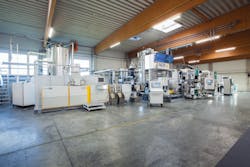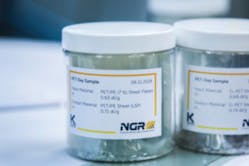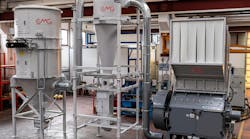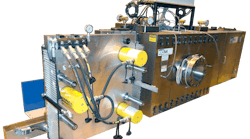At an open house in November at its Feldkirchen, Austria, headquarters, NGR showcased the technology to film producers, displaying a P:React system inline with a Kuhne Group film extruder. The company also announced that it has installed P:React systems at an undisclosed film manufacturer in Europe and another in the U.S.
The system is designed to transform various forms of post-consumer and post-industrial PET into food-grade recycled PET in minutes, with-out an intermediate pelletizing step. Last year, the company made several improvements to the system to facilitate direct processing of PET into films. Although NGR would not disclose details, those changes include mechanical modifications to improve the stability of the material flow at the system’s outlet, said Patrick Steinwendner, head of product management for NGR. The company achieved this by improving control of the material’s residence time, modifying the discharge pump and optimizing how individual components work together.
The process begins with molten PET entering the P:React system, which forms it into strands to increase the resin’s surface area. Under vacuum, the PET condenses, increasing the material’s intrinsic viscosity (IV). The vacuum also removes any impurities, making it suitable for food-contact applications.
P:React automatically measures the resin’s IV, allowing the system to control the IV of the final product with a high degree of accuracy. It can even produce PET with an IV higher than that of the original feedstock.
When it leaves the P:React system, the PET can be extruded into pellets, or fed directly into processing equipment making fibers, sheet or film, including FDA-approved film with strong optical and mechanical properties. The films are primarily suitable for thermoforming applications.
One of the benefits of the P:React system is that bottle flake, scrap fiber, sheet, thermoforming waste, strapping and other lower-value scrap can be recycled into higher-value recycled products, NGR said.
Additionally, LSP can safely process copolymer forms of PET (PET-G) and polyolefins such as PE. Many commercially available PET films have sealing layers made from PETG or PE. However, PET-G and PE have significantly lower glass transition temperatures than standard PET, Steinwendner said. In conventional solid-state polycondensation processes, this property leads to clumping.
“With LSP, PETG is normally melted and decontaminated with the other PET,” Steinwendner said. That also applies to PE, which does not condense but is distributed homogenously throughout the melt.
Process stability is another big advantage of the technology, and an important factor that allows P:React to directly feed downstream equipment making film or sheet. In conventional recycling processes using an extruder, the material flow fluctuates, which can be problematic for connected downstream processes, Steinwendner said.
In LSP, the outgoing material is in liquid form and is conveyed with a mechanical pump. “Instead of an extruder cylinder, the material is conveyed from a pipe,” he said.
“This results in a 100 percent stable material flow,” Steinwendner said. “Experience, especially in fiber production, shows this is an increased output due to fewer process interruptions.”
The process also can use as little as 40 percent to 50 percent of the energy used in traditional recycling processes. This is due in part to the rapid decontamination, made possible by the large surface area of the polymer in its molten phase.
“These two features, liquid phase, plus maximization of material surface by means of fiber formation, make the decontamination [ability] of LSP so high-performance and fast,” Steinwendner said.
Each LSP system can be designed according to input material and material form, as well as the requirements on the output side. However, NGR lists four standard P:React machines: The P:React 300 processes between 330 pounds and 880 pounds per hour; the P:React 600 handles an hourly range of 680 pounds to 1,540 pounds; the P:React 1200 manages 1,320 pounds to 3,080 pounds per hour; and the P:React 2000 has a capacity of 3,080 pounds to 4,840 pounds per hour.
Overall, LSP opens up more possibilities for recycling a wide variety of PET scrap directly into new products, Steinwendner said. “LSP thus has the potential to make a significant contribution to the worldwide reduction of PET waste,” he said.
Allan Gerlat, correspondent
Contact:
Next Generation Recycling Machines Inc.
Norcross, Ga., 678-720-9861,








